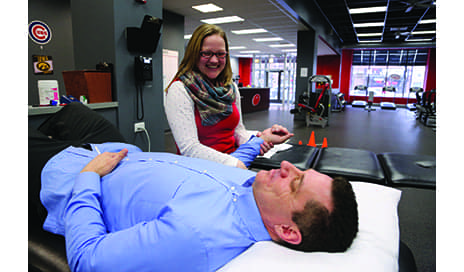
Most acute pain does very well on its own with reassurance, graded activity, and slow reintroduction of previously painful actions. With an injury screen, a patient can consult with a physical therapist about whether someone is expected to recover on their own or will need a higher level of structured care.
By Thomas Denninger, DPT, OCS
Pain or pain with activity is the primary reason a patient seeks care from a physical therapy provider, like ATI Physical Therapy. Rates of chronic pain continue to increase and have reached epidemic level by some experts, citing that 1 in 3.5 individuals are dealing with persistent pain at any given moment in the US. This has led to increasing surgical, interventional, and pharmaceutical rates, including the much-publicized dramatic increase in opioid prescription. Care from a physical therapist for acute or persistent pain is a cost-effective alternative or supplemental treatment option with minimal to no side effects. Pain can manifest from acute injuries or sprains and strains or joints such as knees and ankles; can be due to ongoing loading and repeated use, such as tendonopathies of the Achilles and Patellar tendon; can be due to neural compression such as carpal tunnel syndrome or lumbar radiculopathy; or can be due to progressive sensitivities such as chronic low back pain or fibromyalgia.
Although a distinct injury may be present, up to 60% of patients cannot identify an event that led to their pain complaint. With this lack of clarity on how and when things began, patients can often have apprehension regarding if and when their pain may end. This fear can further be confounded by fears regarding impact on work and recreation, pursuit of the right treatment, whether physical activity can be helpful or harmful, and concerns over cost.
[sidebar float = “right” width = “250”]Product Resources
The following companies provide products for pain management:
Amrex Electrotherapy Equipment
www.amrexusa.com
Ari-Med Pharmaceuticals
www.ari-med.com
Battle Creek Equipment Company
www.battlecreekequipment.com
China-Gel
www.chinagel.com
Everyway4all
www.everyway4all.com
E-Z Release Myofascial Technique
www.ezreleasemyo.com
LightForce Therapy Lasers
www.lightforcelasers.com
Parker Laboratories
www.parkerlabs.com
Richmar
www.richmarweb.com
Sombra Professional Therapy Products
www.sombrausa.com
Sore No More
www.sorenomore.com
Southwest Technologies
www.elastogel.com[/sidebar]
Danger Signals
The first step in addressing these concerns can be basic pain neurophysiology education regarding how the body uses pain as an alarm system to notify the person of real or perceived danger. These danger signals may represent true tissue damage, or may reflect a sensitivity that is further heightened by fear and anxiety. The good news is that most acute pain does very well on its own with reassurance, graded activity, and slow reintroduction of previously painful actions. Knowledge is key here. With an injury screen, a patient can consult with a physical therapist on whether someone is expected to recover on their own or will need a higher level of structured care.
A component of this education is setting realistic expectations of when someone will be back to all the activities they enjoy, and pain free with these activities. An ideal outcome is contingent on tissue healing rates for acute injuries and the plasticity of the nervous system in more long-term complaints, and everyone is different. A physical therapist will set realistic expectations for return to activity and pain level based upon the original injury (if present), location of complaint, whether it was postoperative, irritability of the tissue, and other factors including age and general health and activity.
Services offered by many physical therapy organizations for the management of acute and chronic pain include therapeutic exercise (aerobic, mobility, and strengthening), thrust, and non-thrust joint mobilization/manipulation. Soft tissue mobilization can also be used to manage pain, including techniques such as massage, trigger point dry needling, and instrumented soft tissue mobilization, including ASTYM and Graston. Pain Neuroscience Education and taping are also important options for controlling pain symptoms. Kinesio Holding Corp, Albuquerque, NM, offers a line of therapeutic tape as well as a education events about the Kinesio Taping Method that explore fundamentals and advanced taping techniques. Likewise, E-Z Release Myofascial Technique, Carmel, Calif, offers myofascial technique seminars that focus on educating therapists about a method of releasing soft tissue by using E-Z Release Tab Tape. The technique applies traction, decompression, and mobilization to soft tissue restrictions layer by layer using the tape.
Physical modalities aimed at modulating the incoming danger signal are also part of the physical therapist’s pain management toolkit. Modalities take many different forms and can be very helpful in decreasing pain and discomfort so that active treatments can be tolerated.
[sidebar float = “right” width = “250”]Lasers, Light, and the Power to Relieve Pain
Therapeutic laser is a modality that can be used to alleviate pain and inflammation. Unlike surgical lasers, therapeutic lasers do not have highly focused beams but instead deliver a lower power density laser light that is therapeutic instead of damaging. Class III (up to 0.5 W) lasers (often termed Low Level Laser Therapy or Cold Laser) have been in use in physical therapy and rehabilitation since 1972. The FDA clearance of the first class IV (greater than 0.5 W) therapeutic laser in 2003 has led to the development and use of higher-power lasers with a much larger treatment beam (still with therapeutic power densities similar to the class III devices). The larger treatment beam area allows the treatment of larger areas of pain in reasonable treatment times. For some clinics this can make therapeutic lasers a leading choice for alleviating pain, especially in sports medicine and rehabilitation. The term “photobiomodulation therapy” is a more accurate term for the modality since it includes the use of higher-powered lasers and in light-emitting diodes. Photobiomodulation therapy can provide non-invasive, non-pharmacological pain relief, and can also promote healing of damaged tissue by a process termed photobiomodulation.
Photobiomodulation has been studied in both cell and animal models. Within the cell, light in the visible (400-700 nm) and near-infrared (700-1000 nm) acts on mitochondria to increase adenosine triphosphate (ATP) production, modulate reactive oxygen species, and induce transcription factors. These effects in turn lead to increased cell proliferation and migration, modulation in levels of cytokines, growth factors and inflammatory mediators, and increased tissue oxygenation. The results of these biochemical and cellular changes in patients include such benefits as increased healing and reduction of pain for a variety of conditions, including musculoskeletal injuries, arthritis, and neuropathies.[/sidebar]
Modalities and Pain Management Principles
Classically, one of the most popular modes of modalities have been electrical stimulation, including TENS (transcutaneous electrical nerve stimulation), Russian Stim, high volt, and interferential current (IFC). The use of electrical modalities helps decrease pain and discomfort by utilizing the Gate Theory of Pain, which essentially reasons that if the body is focusing on a set of sensations (such as the tingling of electricity), it is less adept to sense pain and discomfort. This works on the similar principle as rubbing a sore area or blowing on a burn. High levels of electrical stimulation have also been proposed to activate endogenous opioids and decrease pain through the body’s naturally occurring substances.
There are multiple manufacturers, each with their distinguishing features. Decisions to purchase may be centered upon maximal output and portability. Many electrical stimulation and TENS devices are portable and allow someone to complete their activities while having the pain-relieving benefit as opposed to being stuck in one position. A physical therapist may use eStim or TENS as a component of treatment and can assist in determining if a home unit may be helpful for a patient. Some offices may have home units to disperse through direct sale, through a third-party supplier, or may suggest purchase through a vendor or retail outlet.
Sources for these technologies include Richmar, Chattanooga, Tenn, which makes the Winner EVO Combination unit. This device can provide simultaneous four-channel electro stimulation and therapeutic ultrasound, with ultrasound delivered in continuous or pulsed modes. Its on-board electro stimulation waveforms include IFC, Russian, pre mod, micro, and high volt. Zimmer MedizinSystems, Irvine, Calif, is another provider in this market, offering the TENS 5. This device has dual channels, is pocket-sized, and provides five modes of stimulation.
Topical Tools for Temporary Relief
Operating on the Gate Theory of Pain, topical analgesics, such as Biofreeze from Cuyahoga Falls, Ohio-based Performance Health, can offer short-term pain relief and allow easier motion and participation. Most analgesics offer a numbing agent to help relieve superficial tissue injuries, but may also include a fast-evaporating substance which gives a cooling sensation. As with electrical modalities, this mitigates danger signals by focusing the patient’s nervous system and attention to a more pleasant sensation. Recommendation is often based upon a PT’s personal experience or preference, with odor being another determining factor. Some topical analgesics have a strong smell, which may decrease compliance.
Among the providers of topical analgesics is Moab, Utah-based Sore No More, which offers the gel pain reliever Sore No More. This product is formulated with natural ingredients such as menthol, camphor, capsaicin, and several others to provide temporary relief. Sore No More is available in jars or a pump bottle. Another topical analgesic that can be used for warm therapy, cool therapy, massage therapy, or ultrasound therapy is Sombra, offered by Albuquerque, NM-headquartered Sombra Professional Therapy Products. Sombra’s Warm Therapy pain-relieving gel is formulated to be non-greasy, non-staining, and alcohol free, and to provide relief for minor muscle and joint pain. China-Gel, available from Arlington Heights-based China-Gel, is still another option and is formulated as a greaseless therapeutic gel with seven herbal ingredients. China-Gel is offered for professional use by PTs to stimulate endorphin release for the reduction of pain, and is dispensed from standard-size tubes and bottles or from a gallon-size container with pump.
Deep Heating
Thermal modalities such as moist heat have demonstrated benefits for short-term pain relief. Other heating modalities such as ultrasound and diathermy have also long been components of physical therapy practice. Ultrasound is hypothesized to use sound waves to penetrate deeper than moist heat traditionally would. Many patients report pain relief and cite ultrasound as an important component of their treatment. However, most research has been mixed. Ultrasound has shown to be effective in calcific tendonopathy of the shoulder and also for carpal tunnel syndrome. Short-wave diathermy is another deep heating modality that has recently experienced a resurgence in popularity. It uses high-frequency electromagnetic currents to create deep heating between conductor plates or through an induction coil.
Treating with Laser
Therapeutic Laser (or cold laser) is another physical modality that has been shown to have positive benefits in the recovery of acute and chronic tissue lesions. Laser uses highly focused light which penetrates tissue and may assist in increasing local blood circulation and result in increased healing. There is additionally some evidence that would suggest laser therapy increases energy rates within damaged cellular tissue, which may assist in healing.
Sources for Class IV laser devices for pain relief include Pivotal Health Solutions-PHS Therapeutics, Watertown, SD, which offers the Apollo Class IV cold laser system as desktop or handheld units. Another manufacturer is LightForce Therapy Lasers, Newark, Del, which offers LightForce Class IV lasers. This product line includes the LightForce FX and LightForce EXP, which are designed to function in pulsed or continuous mode. It should be noted there are devices on the market that use red and near-infrared light as a healing modality, and for which the term “low level laser therapy (LLLT)” is often applied. However, In 2014, the North American Association for Laser Therapy and the World Association of Laser Therapy reached an agreement to add the term “photobiomodulation therapy” to the vocabulary of the Medical Subject Headings (MeSH) database. This step was to assign a more specific name to this type of treatment. PTP
Thomas Denninger, DPT, OCS, serves as a regional director for ATI Physical Therapy and is located in Greenville, SC. He is a 2008 graduate of Sacred Heart University’s Doctor of Physical Therapy Program and is recognized as a Fellow of the American Academy of Orthopedic Manual Physical Therapists. For more information, contact [email protected].





